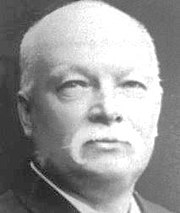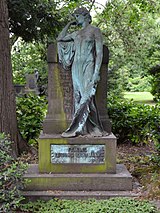Edmund Lührmann Foundation
The Edmund Lührmann Foundation was a hospital and sanatorium with an attached convalescent home for people suffering from nerves in Essen . It was founded in 1903 with donations from Edmund Lührmann by the city of Essen and dissolved after being destroyed in the Second World War .
history
On March 14, 1893, Edmund Lührmann gave the city of Essen a total of 30,000 marks to be used in a municipal institution for the education of neglected children of Protestant denomination and for Protestant orphanage children. He stated that a foundation should be established for this purpose, which should be named Eduard Lührmann Foundation in memory of his father . For this purpose Edmund Lührmann transferred another 70,000 marks to the city on November 23, 1894. In accordance with a statute of the now so-called Lührmann Foundation passed by the City Council of Essen in March 1903, the 100,000 Marks donated in 1893/1894 and a further 150,000 Marks donated in 1903 were to be used. In the statutes, the city committed itself to building and maintaining a hospital and sanatorium, combined with a convalescent home for people suffering from nerves, from the entire capital.
As a result, the foundation stone was laid on February 28, 1905 in the presence of Edmund Lührmann on the Stenshof site, near the area of the later botanical garden in the Grugapark in Rüttenscheid . The Essen patron donated, among other things, electric baths to the institution. The inauguration of the rest home, located between forest and fields, took place on July 16, 1907. When his daughter Helene (married Girardet) died that year, he founded the Essen Helenen Foundation with 15,000 marks and set up the Helen room in the rest home . In addition, on the occasion of his silver wedding anniversary in 1907, Lührmann signed over his villa in Werningerode worth around 110,000 marks to the city of Essen with the stipulation that a spa house be set up and leased there and that the proceeds should be donated to the convalescent home for the mentally ill in Essen. In addition, for this purpose there was the transfer of shares worth 72,000 marks with dividend coupons worth 100,000 marks. Lührmann initiated these foundation instructions from Hanover in a letter to the Lord Mayor of Essen, Wilhelm Holle . In it, Lührmann also described the close ties to his hometown and explained his guiding principle: Do good and don't get tired .
The Edmund Lührmann Foundation was headed by Dr. Hakländer, she went to Dr. Rock over. After several other senior physicians, Dr. Baumgart took over the office. In 1914 the institution received four additional rooms, as the first director, Dr. Hakländer, moved into a newly built extension with his family. In the First World War , from 1915, the institution was used as a reserve auxiliary hospital, so it was partially occupied with wounded, mainly people with head injuries.
After the First World War, the foundation had financial problems due to high inflation, so that, for example, the recreation home was rented to the Knappschaftsverein based in Bochum , which continues to operate it in Lührmann's sense. According to a contract with the Knappschaftsverein, the house was called Knappschafts Nervenkrankenhaus - Lührmann Foundation in Essen from July 1, 1921 . After the contract expired in 1933, the Rhenish Mother House of the Red Cross , which provided the sisterhood for the city hospital, leased the home, and it became a residential building for student nurses and was named the Lührmannstift sister house .
On October 23, 1944, the nurses' house was bombed and one person was killed. After the house was vacated, there were more hits two days later. A part of the house remained intact, so that it was used as a hospital. A reconstruction of the house was out of the question, whereupon the foundation statutes were repealed on December 15, 1955 with retroactive effect to June 26, 1948. The City Council of Essen decided to use the foundation's assets to rebuild the destroyed neurological department of the mental hospital of the municipal hospitals, from which the Essen University Hospital emerged in 1963 . According to Edmund Lührmann's will, the city of Essen again entered into the obligation to set up and maintain a hospital and remedial facility for people suffering from nerves in the city hospital. It was also determined that, in memory of the foundation, the name Edmund-Lührmann-Stiftung will be linked to the building in Essen, Külshammerweg 40, which today houses a horticultural center and the horticultural school of the Rhineland Chamber of Agriculture . Furthermore, the streets Lührmannwald and Lührmannstraße are meant to commemorate the founder. The Lührmannstraße, which was laid out as Paulstraße in 1897, was named Reinhardstraße in 1906 and finally became Lührmannstraße on June 7, 1907.
Edmund Lührmann

|

|
|
|
Edmund Lührmann
|
Tomb at the Ostfriedhof Essen
|
The Essen merchant Edmund Lührmann, who also worked in Berlin , was an important patron of the city of Essen. He was born the son of Alwine Scheidt († 21 February 1893) and the trades born Christian Gottfried Eduard Lührmann († 24 November 1887) on 15 February 1845 in Essen. He later lived in Wernigerode as a pensioner until 1907 . His wife was Marie, née Boye (* July 18, 1854, † January 9, 1937), with whom he had a daughter Helene (* 1885; † 1907) and two sons. After Lührmann started several trips from 1907, he died of a heart attack on February 23, 1909 in Buenos Aires while on a ship . His urn was transferred to Essen and buried on April 19, 1909 in the cemetery at Kettwiger Tor in Essen, where he was honored by Mayor Wilhelm Holle in his speech. Holle laid a wreath dedicated to the faithful son and benefactor of his hometown . In addition to Lührmann's two sons, the men's choir also attended the funeral, of which Lührmann was an honorary member. The choir sang the song Über den Sternen with the text by Ida Hahn-Hahn and the melody by Franz Abt . An obituary dated February 24, 1909 says: His memory will live on in his foundations . Today, after the cemetery at Kettwiger Tor was closed in 1955, the tomb is located in the Ostfriedhof in Essen .
See also
Web links
- Historical portal Essen: Edmund Lührmann ; accessed on April 6, 2018
Individual evidence
- ↑ Essener Volkszeitung (No. 40) of October 26, 1907: New Lührmann Foundation
- ↑ Official Gazette of the City of Essen No. 14 (1955)
- ↑ Erwin Dickhoff (ed.): Essener streets. City history as reflected in the street names . Essen 1979, ISBN 3-87034-030-4 , p. 183 .
- ↑ Erwin Dickhoff (ed.): Essen heads: who was what? Essen 1985, ISBN 3-87034-037-1 , p. 157 .
- ↑ Essener Volkszeitung (No. 42) of April 20, 1909: Burial of the deceased pensioner Edmund Lührmann
Coordinates: 51 ° 25 ′ 48 ″ N , 6 ° 59 ′ 0.3 ″ E
